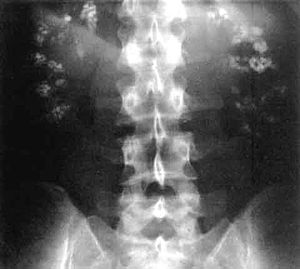Renal tubular acidosis
| Renal tubular acidosis | |
|---|---|
 |
|
| Significant nephrocalcinosis (calcification of the kidneys) on a frontal X-ray (radiopacities (white) in the right upper and left upper quadrant of the image), as seen in distal renal tubular acidosis. | |
| Classification and external resources | |
| Specialty | nephrology |
| ICD-10 | N25.8 |
| ICD-9-CM | 588.89 |
| OMIM | 179800 |
| DiseasesDB | 11705 |
| eMedicine | med/1071 |
| MeSH | D000141 |
Renal tubular acidosis (RTA) is a medical condition that involves an accumulation of acid in the body due to a failure of the kidneys to appropriately the urine. In renal physiology, when blood is filtered by the kidney, the passes through the tubules of the nephron, allowing for exchange of salts, acid equivalents, and other before it drains into the bladder as urine. The metabolic acidosis that results from RTA may be caused either by failure to reabsorb sufficient bicarbonate ions (which are alkaline) from the filtrate in the early portion of the nephron (the proximal tubule) or by insufficient secretion of hydrogen ions (which are acidic) into the latter portions of the nephron (the distal tubule). Although a metabolic acidosis also occurs in those with renal insufficiency, the term RTA is reserved for individuals with poor urinary acidification in otherwise well-functioning kidneys. Several different types of RTA exist, which all have different syndromes and different causes.
The word acidosis refers to the tendency for RTA to lower the blood's pH. When the blood pH is below normal (7.35), this is called acidemia. The metabolic acidosis caused by RTA is a normal anion gap acidosis.
...
Wikipedia
